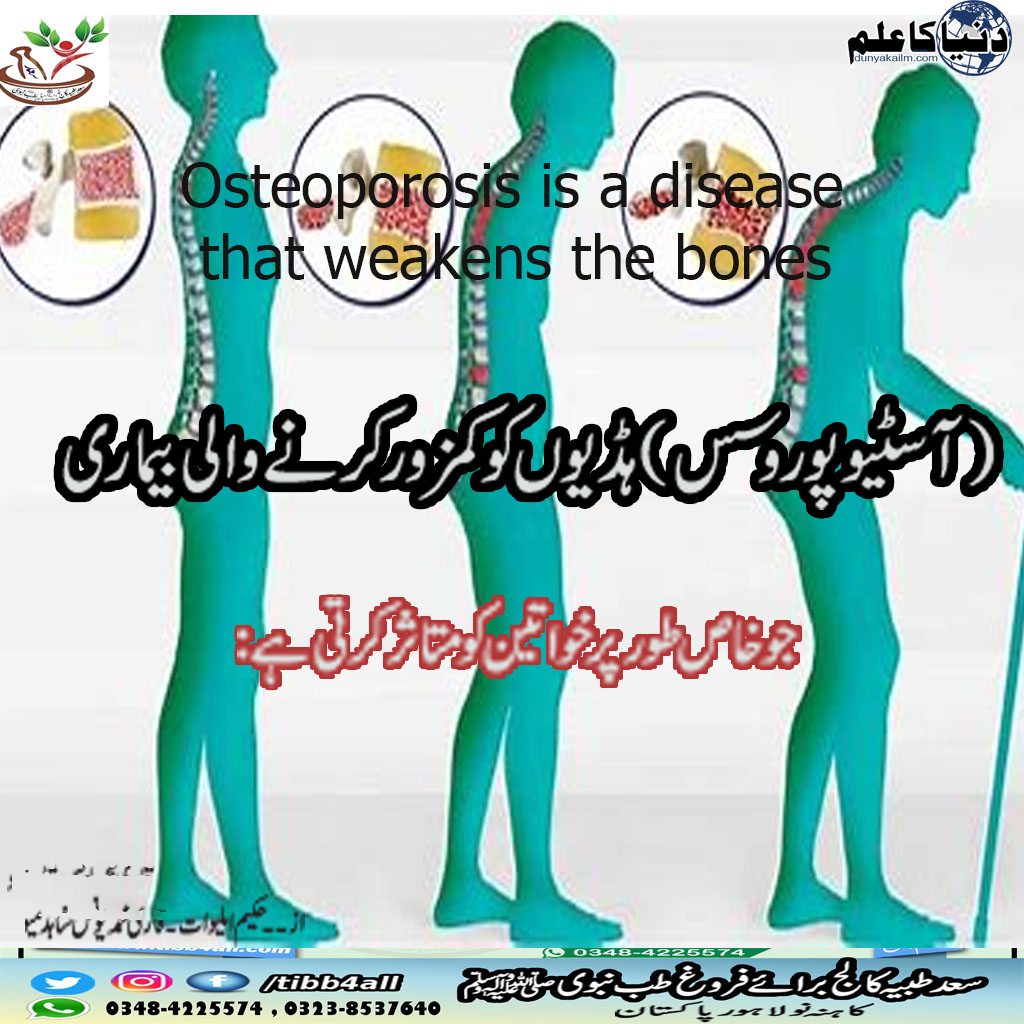- Home
- Hakeem Qari Younas حکیم قاری محمد یونس شاہد میو
- Osteoporosis is a disease that ...

Osteoporosis is a disease that weakens the bones
Which especially affects women:
reasons
Your bones are in a constant state of renewal – new bone is formed and old bone is broken down. When you’re young, your body makes new bone faster than it breaks down old bone, and your bone mass increases. The process slows down after the early 20s, and most people reach their peak bone mass by age 30. As people age, bone mass is lost faster than it is created.
woman:
Bone loss occurs with aging in all adults. This can lead to osteopenia, which is moderate bone loss, or osteoporosis, which is severe bone loss. In both conditions, the bones become thinner and more porous due to the loss of mineral deposits in the bones.
Osteopenia and osteoporosis
They are usually painless until the bone is broken or fractured. This fracture usually occurs in the spine, hip, or wrist, but can also occur in other bones. Without medical treatment, men and women lose 1 to 3% of their bone mass each year over the age of 50. As bone strength or density decreases, people are more likely to develop osteoporosis or fractures.
Bone weakness is gradual.
Osteoporosis can develop over many years. As you age, you are more likely to develop osteoporosis. Loss of estrogen in women due to menopause, and low testosterone levels in men also increase bone loss. Women who experience early menopause or have their ovaries removed at a young age are more likely to experience increased bone loss. Certain medications, drinking too much alcohol, and smoking can also increase your risk
1. **What is osteoporosis?*
* Osteoporosis is a disease that weakens the bones, making them more prone to fractures (broken bones). It is often called the “silent disease” because there are usually no symptoms until a fracture occurs. [Image of Osteoporosis Bone]

Osteoporosis causes bones to become weak and brittle – so brittle that a fall or even the slightest stress, such as bending over or coughing, can cause a fracture. Fractures related to osteoporosis usually occur in the hip, wrist or spine.
Bone is living tissue that is constantly being broken down and replaced. Osteoporosis occurs when new bone formation does not keep up with the loss of old bone
2. **Who gets osteoporosis?*
* Women are more likely to develop osteoporosis than men. About 80 percent of osteoporosis patients are women. How likely you are to develop osteoporosis depends in part on how much bone you gained in your youth. Bone density is partly inherited and also varies by ethnic group. The higher your bone mass, the more bone you have “in the bank” and the less likely you are to develop osteoporosis as you age.
3. **Why are women at greater risk?*
* There are a few reasons why women are at a higher risk of osteoporosis:
* Women in general
But men have smaller, thinner bones.
* Women lose bone faster after menopause due to decreased estrogen production. Estrogen helps protect bones (details to come).
*Women versus men
Live longer which gives them more time for bone loss.
4. **Risk Factors for Osteoporosis in Women:**
Age: The risk of osteoporosis increases with age.
* Family history:
Having a parent or sibling with osteoporosis increases your risk.
* Race: White and Asian women are at higher risk than black and Hispanic women.
*Body size: Smaller, thinner women are at higher risk.
* Certain medical conditions: Conditions such as rheumatoid arthritis, lupus, and celiac disease may increase your risk.
* Medications: Long-term use of certain medications, such as corticosteroids, can increase your risk.
Lifestyle factors: Lack of exercise, smoking, and low intake of calcium and vitamin D can increase your risk.
Dietary factors
Osteoporosis is more likely to occur in people who have:
Low calcium intake. A lifelong lack of calcium contributes to the development of osteoporosis. Low calcium intake contributes to decreased bone density, early bone loss and increased risk of fractures.
eating disorder. Severely restricting food intake and being underweight weaken bones in both men and women.
Gastrointestinal surgery. Surgery to reduce the size of your stomach or remove part of the intestine limits the amount of surface area available to absorb nutrients, including calcium. These surgeries include those that help you lose weight and other gastrointestinal disorders.
Hormone levels
Osteoporosis is more common in people who have too much or too little of certain hormones in their bodies. Examples include:
Sex hormones. Decreased sex hormone levels weaken bones
. Menopause
. Declining estrogen levels in women at menopause is one of the strongest risk factors for developing osteoporosis. Prostate cancer treatments that reduce testosterone levels in men and breast cancer treatments that reduce estrogen levels in women are likely to accelerate bone loss.
Thyroid problems. Too much thyroid hormone can cause bone loss. This can happen if your thyroid is overactive or if you take too much thyroid hormone medication to treat an underactive thyroid.
other glands. Osteoporosis has also been linked to overactive parathyroid and adrenal glands.
5. **Symptoms of Osteoporosis:*
* Symptoms of osteoporosis usually do not occur until a fracture occurs. However, some people with osteoporosis may experience back pain, slouched posture, or loss of height.
Medical problems. Steroids and other drugs
Long-term use of oral or injected corticosteroid medications, such as prednisone and cortisone, interferes with the bone remodeling process. Medications used to treat or prevent osteoporosis have also been linked to:
Visits
Gastric reflux.
Cancer.
Transplant rejection.
Medical problems
The risk of osteoporosis is higher in people who have certain medical problems, including:
Celiac disease.
Inflammatory bowel disease.
Kidney or liver disease.
Cancer.
Multiple myeloma.
Rheumatoid arthritis.
6. **Diagnosis of Osteoporosis:*
* A bone density test is used to diagnose osteoporosis. This test measures your bone mineral density.
Lifestyle choices
Certain bad habits can increase the risk of osteoporosis. Examples include:
inactive lifestyle.
People who spend more time sitting have a higher risk of osteoporosis than people who are more active. Any weight-bearing exercise and activities that promote balance and good posture are good for your bones, but walking, running, jumping, dancing and weightlifting seem to be especially helpful.
Excessive consumption of alcohol.
Regular consumption of more than two alcoholic drinks a day increases the risk of osteoporosis.
tobacco use.
The exact role of tobacco in osteoporosis is unclear, but it has been shown that tobacco use contributes to weaker bones.
7. **Prevention of Osteoporosis:*
* There are many things you can do to help prevent osteoporosis, including:
* Eat a healthy diet that contains calcium and vitamin D.
* Exercising regularly, including weight-bearing exercises.
* Maintaining a healthy weight.
* No smoking.
* Limiting alcohol intake.
Complications
Bone fractures, especially in the spine or hip, are the most serious complications of osteoporosis. Hip fractures are often caused by falls and can result in disability and an increased risk of death within the first year after injury.
In some cases, broken bones can occur in the spine even if you haven’t fallen. The bones that make up your spine, called the vertebrae, can weaken to the point of collapsing, which can result in back pain, loss of height and a forward posture.
8. **Treatment of Osteoporosis:*
* There is no cure for osteoporosis, but there are treatments that can help slow bone loss and prevent fractures. These treatments include medications, such as bisphosphonates and denosumab, and hormone therapy.
9. **IMPORTANCE OF BONE HEALTH FOR WOMEN:*
* Maintaining good bone health is important for all women, but it is especially important for women who are at risk for osteoporosis. Strong bones can help prevent fractures and keep you active and independent as you age.
10. Some tips to prevent bone loss
To help keep your bones strong and prevent or slow bone loss with aging, focus on two important things: keeping your bones healthy and preventing fractures. Everyone can take steps to help keep bones strong and healthy throughout life. You can start today. The top five things to keep bones healthy are being active or exercising, eating calcium-rich foods, getting enough vitamin D, quitting smoking and limiting alcohol.
Exercise helps strengthen bones, slows bone loss, and improves fitness. Aim for 30 to 60 minutes a day with a combination of weight-lifting, aerobic, muscle-strengthening, and non-impact exercises. Weight-bearing exercises are activities performed on your feet with your bones supporting your weight. Some of these types of exercise include walking, jogging and dancing. Tai Chi is a good example of non-stimulating exercise. Talk to your doctor about which exercise might be best for your situation.
It is better to get calcium from your food than from a pill. Dairy products, some green vegetables such as spinach, broccoli, or kale, and calcium-fortified fruit juices and soy drinks contain good amounts of calcium. In general, the goal is to get at least three servings per day from your diet. If you are not getting enough calcium from your diet,
A calcium supplement may be necessary. Supplements are well absorbed, usually inexpensive, and easy to take. If you take a calcium supplement, it’s best to combine it with vitamin D.
Vitamin D is important for calcium absorption and maintaining bone health. Vitamin D is usually made in the skin with enough sunlight but is also found in some foods and vitamin supplements. Ask your healthcare provider for more information about how much vitamin D you need and what to do about supplements.
If you smoke, stop. Smoking increases the risk of osteopenia and osteoporosis. Alcohol consumption can also increase the risk of developing osteoporosis. Limit alcohol consumption to one drink a day if you’re a woman, and two drinks a day if you’re a man.
You can help prevent fractures. Two important things you can do to help are fall prevention and medication. Falls are the biggest risk factor for fractures. Take steps to prevent falls in your home, keep rooms and hallways well lit. Don’t climb stairs, keep electrical and phone cords out of walkways, and remove carpets when possible.
Some dietary tips.
While some dietary supplements may help promote overall hormonal health, there is no conclusive evidence that they directly increase estrogen levels. It’s important to talk to your doctor before starting any supplements, especially if you have an underlying health condition. Here are some options to discuss with your doctor:
Foods rich in phytoestrogens: These are plant-based compounds that can mimic the effects of estrogen in the body. Some examples include:
Soybeans and soy products (tofu, tempeh, edamame)
Herbs: Some herbs are commonly used to support hormonal health, but research on their estrogen-boosting effectiveness is limited. These include:













